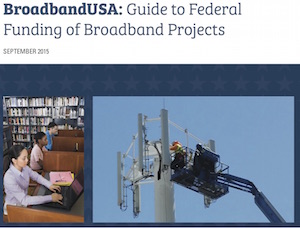
Click to read it for yourself.
A new booklet published by the National Telecommunications and Information Administration outlining ways to finance broadband projects contains no surprises. It’s a summary of federal programs that fund, or might fund, broadband infrastructure and it’s useful as a reference. But there’s no new money on the table, and many of the programs listed are either restricted in scope – Appalachia or tribal areas, for example – or are narrowly focused on specific users, such as libraries or public housing residents.
The list is also heavily weighted toward rural areas, which are served by federal programs that tend to ignore California. The best opportunities for urban infrastructure support comes from either the Economic Development Administration (EDA) or a few indirect money sources, such as the E-rate program for schools and libraries, which provide operating subsidies that might be spent with new service providers. As far as EDA is concerned, though, it’s good news that there’s a clear statement that broadband is moving up the priority list…
EDA’s mission is to lead the federal economic development agenda by promoting innovation and competitiveness, preparing American regions for growth and success in the worldwide economy. Given that broadband is an important ingredient in economic development strategies, EDA funding may be used to support broadband infrastructure projects under EDA’s Public Works and Economic Adjustment Assistance competitive grant programs, within certain parameters.
One troubling aspect is that the list of broadband-friendly federal programs in the booklet is shorter than the report published by the white house a couple of weeks ago. For example, it doesn’t list the agriculture department’s rural community facility program that was highlighted in that report and accounted for about a quarter of the $10 billion that the white house claimed was available for broadband infrastructure projects.
The booklet is a nice resource for beginners, but if you’re already actively involved in trying to develop broadband infrastructure, it’s not nearly as helpful as you probably want.
